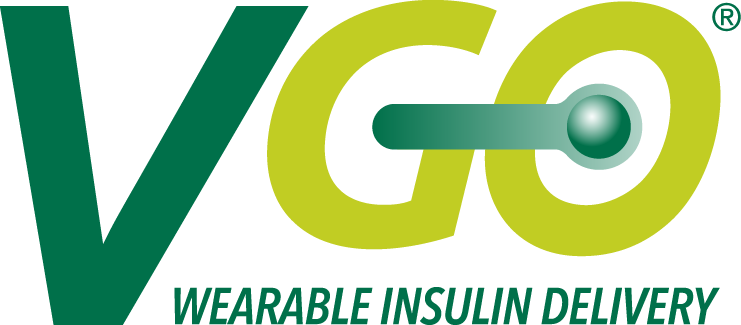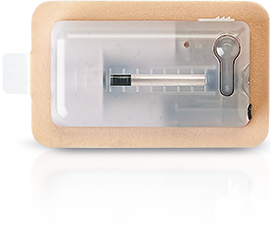
Helps control blood glucose with
simple basal-bolus
insulin delivery
V-Go delivers insulin at a continuous preset basal rate and on-demand bolus
dosing for adults with Type 2 diabetes requiring insulin. V-Go devices are available
in a preset basal rate to deliver 20, 30, or 40 Units of insulin in one 24-hour
period (0.83 U/hr, 1.25 U/hr or 1.67 U/hr, respectively) and on-demand bolus dosing
in 2 Unit increments (up to 36 Units per 24-hour time period). V-Go offers a
simple way to deliver basal-bolus insulin therapy.

V-Go Disposable Insulin Delivery Device has received 510(k) clearance from
the U.S. Food and Drug Administration.
V-Go is designed to simplify basal-bolus insulin therapy and helps make blood
glucose control possible for adults with Type 2 diabetes. V-Go works with no
electronics, batteries, infusion sets, or programming. V-Go is small, lightweight,
and worn under clothing. It measures just 2.4 x 1.3 x 0.5 inches and weighs approximately
1 ounce when filled with insulin. Patients apply a new filled V-Go to the skin daily
for one 24-hour period.
Learn more about V-Go
See How V-GO Works
About Diabetes
Diabetes is a group of diseases marked by high levels of blood glucose resulting from defects in insulin production,
insulin action, or both.1 Insulin is a hormone that
regulates blood sugar (glucose) levels.1
High blood glucose levels can lead to serious complications, including heart disease, stroke, high blood pressure,
blindness, kidney disease, amputation, and even premature death.1,2
Approximately 25.8 million US children and adults have diabetes, including 7 million who are undiagnosed.1
Diabetes is classified into 2 main types: Type 1 and Type 2. The Type 2 form of the disease is most common,
affecting approximately 95% of adults with diabetes.1
In Type 2 diabetes, either the body does not produce enough insulin or the body's cells do not use
insulin properly.1 In Type 1 diabetes, the body stops producing
insulin altogether.1,2
To control blood glucose levels, approximately 5.7 million people in the US with Type 2 diabetes take insulin,4
which is usually administered by injection. More than 3 million of these insulin users have not achieved target
glucose levels currently recommended by the American Diabetes Association.4
In addition, many people with Type 2 diabetes could benefit from insulin therapy, but are reluctant to start
on therapy or skip taking insulin for a variety of reasons, including injection pain, embarrassment about
injecting medication around family and friends or in public, and the perception that insulin will lead to a
loss of freedom.5,6 Continuous subcutaneous insulin
infusion therapy (as with V-Go) in adults with Type 2 diabetes may help blood glucose control.7
Important Risk Information:
If regular adjustments or modifications to the basal rate of insulin are required in a 24-hour period,
or if the amount of insulin used at meals requires adjustments of less than 2-Unit increments, use of
V-Go Disposable Insulin Delivery Device may result in hypoglycemia. The following conditions
may occur during insulin therapy with V-Go: hypoglycemia (low blood glucose) or hyperglycemia
(high blood glucose). Other adverse reactions associated with V-Go use include skin irritation from
the adhesive pad or infections at the infusion site. V-Go should be removed before any
magnetic resonance imaging (MRI) testing.
References:
- Centers for Disease Control and Prevention. National diabetes fact sheet:
national estimates and general information on diabetes and prediabetes in the
United States, 2011. Atlanta, GA: U.S. Department of Health and Human
Services, Centers for Disease Control and Prevention, 2011.
- American Diabetes Association. Diabetes statistics.
http://www.diabetes.org/diabetes-basics/diabetes-statistics/.
September 5, 2012.
- American Diabetes Association. Diabetes basics: Type 1.
http://www.diabetes.org/diabetes-basics/type-1/.
September 5, 2012.
- US Roper Diabetes Patient Market Study. GfK Custom Research LLC, 2011.
-
Petrak F, Stridde E, Leverkus F, Crispin AA, Forst T, Pfützner A.
Development and validation of a new measure to evaluate psychological
resistance to insulin treatment. Diabetes Care. 2007;30(9):2199-2204.
-
Peyrot M, Rubin RR, Khunti K. Addressing barriers to initiation of insulin in
patients with type 2 diabetes. Primary Care Diabetes. 2010;4(suppl 1):S11-S18.
-
Kapitza C, Fein S, Heinemann L, Schleusener D, Levesque S, Strange P.
Basal-prandial insulin delivery in type 2 diabetes mellitus via V-Go: a
novel continuous subcutaneous infusion device. J Diabetes Sci Technol.
2008;2(1):40-46.